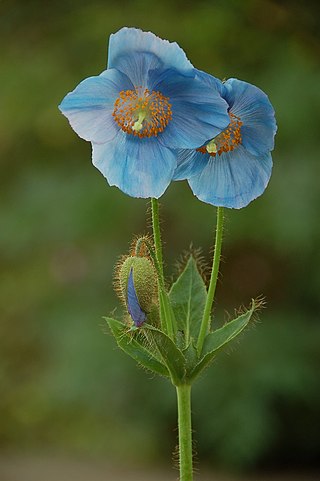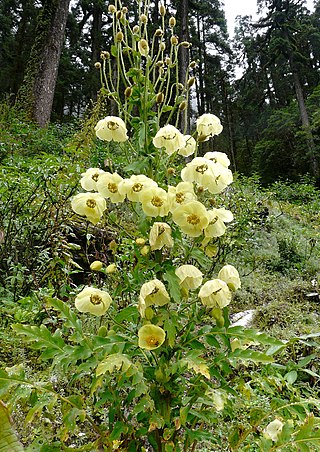
Bergenia is a genus of ten species of flowering plants in the family Saxifragaceae, native to central Asia, from Afghanistan to China and the Himalayan region.

Meconopsis is a genus of flowering plants in the poppy family Papaveraceae. It was created by French botanist Viguier in 1814 for the species known by the common name Welsh poppy, which Carl Linnaeus had described as Papaver cambricum. The genus name means "poppy-like". Himalayan species discovered later were also placed in Meconopsis. In the 21st century, it was discovered that the Himalayan species were less closely related to the Welsh poppy, which has been restored to Papaver. All species now placed in Meconopsis are native to the Himalayas and surrounding regions. They have attractive, usually blue flowers.

Papaver cambricum, synonym Meconopsis cambrica, the Welsh poppy, is a perennial flowering plant in the poppy family Papaveraceae. It has yellow to orange flowers and is widely grown as a garden plant. It is a native of damp, rocky sites in upland areas of Western Europe from the British Isles to the Iberian Peninsula. It has been used since 2006 as the basis for the logo of the political party Plaid Cymru.

Meconopsis betonicifolia, the Himalayan blue poppy, is a species of flowering plant in the family Papaveraceae. It was first formally named for western science in 1912 by the British officer Lt. Col. Frederick Marshman Bailey.

Meconopsis simplicifolia is a perennial in the poppy family, sometimes monocarpic, with a taproot, rosette of leaves with bristly hairs, and blue or purple flowers on leafless stems, native to altitudes of 3,450–5,450 metres (11,300–17,900 ft) in central Nepal and southeastern Tibet.

Bistorta affinis, the Himalayan bistort, fleece flower, or knotweed, is a species of flowering plant in the family Polygonaceae, native to the Himalayas.

Meconopsis grandis, the Himalayan blue poppy, is a species of flowering plant in the poppy family Papaveraceae, native to China (Yunnan), Bhutan, North East India and Nepal.

Meconopsis autumnalis, the Nepalese autumn poppy, is a yellow-flowered Himalayan poppy belonging to series Robustae, and is endemic to the Ganesh Himal range of central Nepal, where it was discovered in 2008 on a research expedition from the University of Aberdeen. In addition to several morphological features, the species is characterised by its late flowering period, which has more than likely resulted in a barrier to gene flow and subsequent evolutionary divergence from the closely related and sympatric species Meconopsis paniculata.

Meconopsis manasluensis is a red-flowered Himalayan poppy belonging to Meconopsis subg. Discogyne, which forms a natural grouping of 6 or 7 species within the genus all characterised by a stylar disc surmounting the ovary. As reflected by the species etymology, M. manasluensis is endemic to the vicinity of the Manaslu Himal of Gorkha district, central Nepal, where it grows at high elevation and so far remains known only from its type collection locality.

Meconopsis horridula, the prickly blue poppy, is a flowering plant from the family Papaveraceae. It is an endangered species that grows in high altitudes. The height of the plant varies from 20 cm to 1m. It is a monocarpic, dicot plant.

Ligusticum scoticum, known as Scots lovage, or Scottish licorice-root, is a perennial flowering plant in the celery family Apiaceae found near the coasts of northern Europe and north-eastern North America. It grows up to 60 centimetres (24 in) tall and is found in rock crevices and cliff-top grassland. It is closely related to, and possibly conspecific with, Ligusticum hultenii from the coast of the northern Pacific Ocean. The plant is edible and contains the compound sotolon, which is also present in fenugreek. The leaves have a flavour similar to parsley or celery, while the seeds taste similar to fenugreek or cumin.
Iris subg. Nepalensis is one subgenus of Iris, also known as 'Himalayan irises'. It was formerly genus Junopsis.

The flora of the U.S. Sierra Nevada alpine zone is characterized by small, low growing, cushion and mat forming plants that can survive the harsh conditions in the high-altitude alpine zone above the timber line. These flora often occur in alpine fell-fields. The Sierra Nevada alpine zone lacks a dominant plant species that characterizes it, so may or may not be called a vegetation type. But it is found above the subalpine forest, which is the highest in a succession of recognized vegetation types at increasing elevations.
Meconopsis lancifolia is a plant species in the genus Meconopsis, in the family Papaveraceae. M. lancifolia is monocarpic, meaning that it flowers only once before dying.

Rheum webbianum is a species of herbaceous perennial rhubarb-relative in the family Polygonaceae from the southwestern Himalayan region, known in (Indian) English as Indian rhubarb, Gilgiti rhubarb or small Himalayan rhubarb.
Caltha scaposa is a low, perennial herb with one or two yellow hermaphrodite saucer-shaped flowers. This marsh-marigold species belongs to the buttercup family, grows in moist alpine fields and is native to the eastern Himalayas and the mountains on the eastern margin of the Tibetan highland.

Brachyscome graminea, commonly known as grass daisy, is a perennial herb in the family Asteraceae and is endemic to Australia. It has mostly mauve-pink or purple daisy-like flowers and a yellow centre.

Meconopsis gakyidiana is a species of blue poppy native to Eastern Bhutan, Western Arunachal Pradesh of India and Southern Xizang of China. It is the national flower of Bhutan.
Cathcartia is a small genus of flowering plants in the family Papaveraceae, native to China, Nepal, the eastern Himalayas, and northern Myanmar. Chloroplast DNA evidence supports a split of Cathcartia from the blue poppy genus Meconopsis in an effort to resolve longstanding taxonomic difficulties in the Himalayan poppies.

Primula wollastonii, also known as Wollaston's primrose, is a species of flowering plant within the genus Primula and family Primulaceae. The species was first discovered and collected by A. F. Wollaston during an expedition to Mount Everest in 1921. The plant would later be scientifically described by Scottish botanist Isaac Bayley Balfour, who named the species P.Wollastonii after a request from Wollaston who had first discovered it.

















